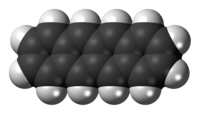Tetracene
 | |
 | |
 | |
| Names | |
|---|---|
| Preferred IUPAC name
Tetracene | |
| Other names
Naphthacene Benz[b]anthracene 2,3-Benzanthracene | |
| Identifiers | |
| 92-24-0 | |
| 3D model (Jmol) | Interactive image |
| ChEBI | CHEBI:32600 |
| ChemSpider | 6813 |
| ECHA InfoCard | 100.001.945 |
| PubChem | 7080 |
| |
| |
| Properties | |
| C18H12 | |
| Molar mass | 228.29 g/mol |
| Appearance | Yellow to orange solid |
| Melting point | 357 °C (675 °F; 630 K) |
| Insoluble | |
| Except where otherwise noted, data are given for materials in their standard state (at 25 °C [77 °F], 100 kPa). | |
| | |
| Infobox references | |
Tetracene, also called naphthacene, is a polycyclic aromatic hydrocarbon. It has the appearance of a pale orange powder. Tetracene is the four-ringed member of the series of acenes, the previous one being anthracene (tricene) and the next one being pentacene.
Tetracene is a molecular organic semiconductor, used in organic field-effect transistors (OFETs) and organic light-emitting diodes (OLEDs). In May 2007, researchers from two Japanese universities, Tohoku University in Sendai and Osaka University, reported an ambipolar light-emitting transistor made of a single tetracene crystal.[1] Ambipolar means that the electric charge is transported by both positively charged holes and negatively charged electrons. Tetracene can be also used as a gain medium in dye lasers as a sensitiser in chemoluminescence.
Jan Hendrik Schön during his time at Bell Labs (1997–2002) claimed to have developed an electrically pumped laser based on tetracene. However, his results could not be reproduced, and this is considered to be a scientific fraud.[2]
In February 2014, NASA announced a greatly upgraded database for tracking polycyclic aromatic hydrocarbons (PAHs), including Tetracene, in the universe. According to scientists, more than 20% of the carbon in the universe may be associated with PAHs, possible starting materials for the formation of life. PAHs seem to have been formed only a couple of billion years after the Big Bang, are widespread throughout the universe, and are associated with new stars and exoplanets.[3]
References
- ↑ T. Takahashi; T. Takenobu; J. Takeya; Y. Iwasa (2007). "Ambipolar Light-Emitting Transistors of a Tetracene Single Crystal". Advanced Functional Materials. 17 (10): 1623–1628. doi:10.1002/adfm.200700046.
- ↑ Agin, Dan (2007). Junk Science: An Overdue Indictment of Government, Industry, and Faith Groups That Twist Science for Their Own Gain. Macmillan. ISBN 978-0-312-37480-8.
- ↑ Hoover, Rachel (February 21, 2014). "Need to Track Organic Nano-Particles Across the Universe? NASA's Got an App for That". NASA. Retrieved February 22, 2014.